Fresh Energy Is Still Intentionally Misleading Minnesotans on Energy Issues: Part Five – The High Cost of Wind Energy
Fresh Energy, a renewable energy advocacy organization, continues to mislead Minnesotan’s on energy issues – and it appears they don’t appreciate our work explaining how wind and solar are driving up the cost of electricity in our state.
In their latest critique of American Experiment, Fresh Energy made multiple attempts to inaccurately portray our organization as misunderstanding how electric rates work, while arguing that wind and solar are the cheapest sources of electricity in our state and are a boon to job creation.
Each of these claims is demonstrably false.
The article below is the fifth in a series of articles that will thoroughly explain how Fresh Energy continues to mislead Minnesotan’s on the cost of electricity in our state.
The Cost of Wind Energy: What They Tell You, and What They Don’t
Many renewable energy advocacy groups, like Fresh Energy, claim that wind energy is now the cheapest energy source available in Minnesota and elsewhere.
As Fresh Energy wrote in their latest critique of American Experiment:
“Wind power is, by far, the lowest-cost electricity generation source in Minnesota. Thanks to extremely strong wind speeds, Minnesota’s utilities have been purchasing long-term contracts for new wind farms for less than 2¢ per kilowatt hour. For comparison, it costs between 2.5-7.5¢ per kilowatt hour to run an existing coal or natural gas power plant. This bears repeating: it’s cheaper to build a brand-new wind farm—with a guaranteed electricity price over the life of the contract—than it is to simply run a coal or natural gas plant that is already built, even at today’s low natural gas prices.”
To begin, Fresh Energy is using what are known as Power Purchase Agreements (PPAs) to justify their claim that wind energy is now cheaper than existing sources, like coal and natural gas.
However, PPAs – or long-term contracts to purchase the electricity generated at a specific power plant – for wind energy include the Production Tax Credit (PTC), which allows wind facilities to obtain $24 per megawatt-hour (MWh) of electricity produced as a tax credit for ten years. It’s important to remember that subsidies do not reduce the cost of wind, they simply change which pocket you pay it out of.
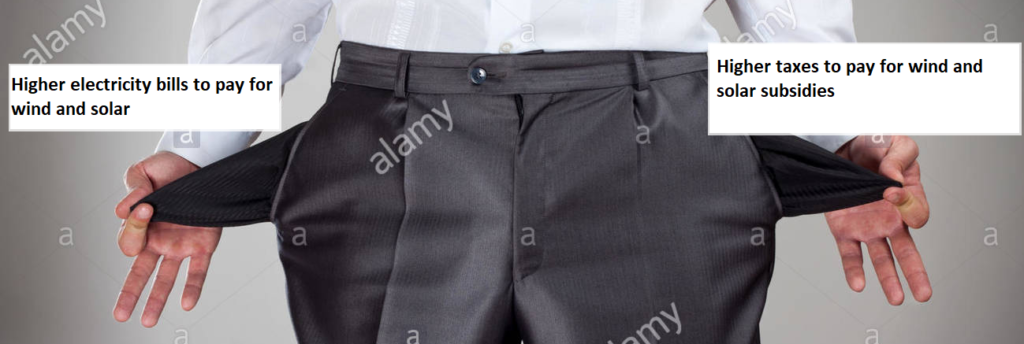
This means that whatever groups like Fresh Energy are claiming the cost of wind energy to be – 2 cents per kilowatt hour (kwh) in the example above – the true cost is at least 1.2 cents per kwh greater, considering that PPAs are usually licensed for twenty years. This would bring Fresh Energy’s stated cost of 2 cents per kwh up to at least 3.2 cents per kwh.
Existing coal generation costs are only 3 cents per kilowatt on average, even with exceptionally low capacity factors in the 40’s and 50’s, according to data obtained by the Federal Energy Regulatory Commission (FERC) Form 1 filings, meaning that wind energy is far from the cheapest energy source available.

It is interesting to mention that major utility companies in Minnesota, like Xcel Energy and Otter Tail Power, admit to exactly this in their resource filings to the Minnesota Public Utilities Commission.
Two tables are shown below – the first from Otter Tail Power and the second from Xcel Energy – showing these utilities expect the cost per megawatt hour (MWh) of electricity generated by wind to increase as at the PTC expires, based on 20-year PPAs.

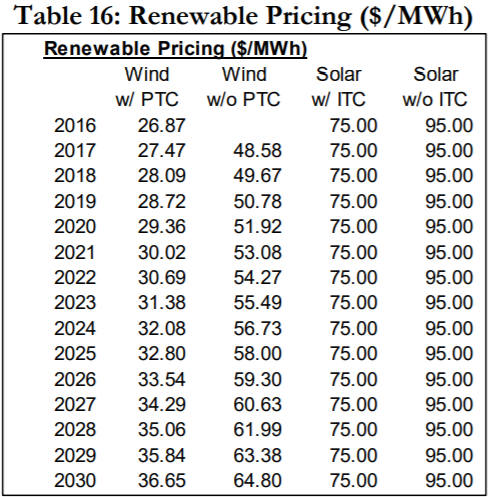
As you can see, with the PTC intact, both Xcel and Otter Tail claim to be paying around $25 per MWh for wind energy – still above the value of 2 cents cited by Fresh Energy above, but it’s close.
However, when the PTC is phased out and wind energy is no longer receiving this massive government subsidy, Xcel and Otter Tail predict the cost of wind energy to increase by 141 percent and 119 percent, respectively, to $64.80 per MWh and $54.69 per MWh by 2030.
This translates to about 6.5 and 5.5 cents per kwh for wind energy – triple the value given by Fresh Energy and double the cost of electricity from existing coal power plants.
Furthermore, by saying wind energy is now cheaper than existing generators, Fresh Energy is misrepresenting the fact that, because wind energy doesn’t produce electricity when the wind stops blowing, wind energy still needs existing generators online for what is known as “load balancing.”
And because wind energy doesn’t actually displace any existing electricity capacity already online, incorporating it will only mean that an electrical grid will have more capacity than it needs to produce the required amount of electricity.
This is exactly what has happened in Minnesota, as the chart below shows. As you can see, despite electricity consumption in Minnesota remaining largely flat since 2004, increasing by merely 3 percent, the total amount of capacity able to generate electricity has increased by 48 percent.
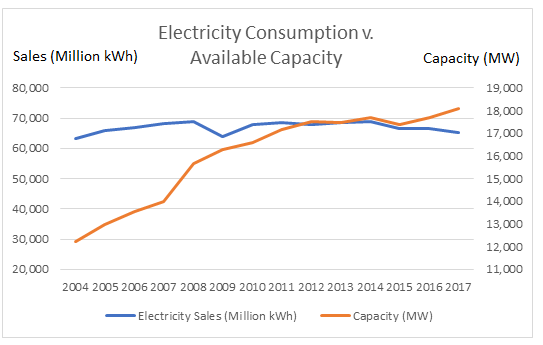
This means we have built so many wind, solar, and natural gas facilities that we now have enough generation capacity to power 2.7 Minnesota’s based on 2017 consumption, even though electricity demand has been flat since 2007.
The cost of operating these power facilities is expensive and is passed directly onto electricity ratepayers.
The High Cost of Wind Energy is Increasing the Cost of Electricity
The PPA cost of wind energy listed by Xcel and Otter Tail doesn’t take into account the cost of load balancing. Additionally, PPAs for wind energy don’t even begin to consider the many other hidden costs that wind generation imposes onto the electrical system.
These costs include additional utility profits, property taxes, transmission additions and upgrades, and increased ramping (the cost attributed to forcing fuel-based generators to ramp their generation up and down more often to accommodate fluctuating wind patterns, increasing their maintenance expenses).
Fuel-based generators either do not impose these costs or do so to a far lesser extent because they’re dispatchable, do not rely on the weather to produce electricity and only need more fuel, and can be placed near population centers. As such, these additional costs should properly be attributed to the true cost of wind energy.
This is exactly what American Experiment’s latest report, Doubling Down on Failure, set out to do.
What we found is that the true cost of wind energy in Minnesota, specifically – without the PTC and after attributing the additional cost of property taxes, utility profits, transmission expenses, and load balancing – comes closer to $113.36 per MWh, or 11.34 cents per kwh, at a 44 percent capacity factor.
On the other hand, the cost of existing coal in Minnesota was $34.17 per MWh in 2017 at a 57 percent capacity factor, after CO2 reduction upgrades, and the cost of existing natural gas was $46.61 per MWh at a 40 percent capacity factor.
Which would you rather choose?
Option 1 – Electricity that costs 3 to 5 cent per kwh from reliable fuel-based power facilities that can always produce more electricity, no matter the weather conditions, by simply adding more fuel; or
Option 2 – Electricity that costs more than 11 cents per kwh from intermittent renewable power facilities that are incredibly expensive to build and need backup generation because they can’t power the electrical grid on their own for 100 percent of the time.
The answer should be a no-brainer, especially when considering that by using a certain type of fuel-based generator [eh-hem, nuclear], Minnesota could hypothetically reduce CO2 emissions to almost zero.
The interesting thing with wind and solar energy is that there isn’t even a hypothetical situation where they could reduce as much CO2 as nuclear power – and if they did, it would cost exponentially more.
To put it plainly – there is simply no way you can increase the amount of wind energy on the electrical grid without also increasing electricity rates and bills in unison, as shown in the graph below.
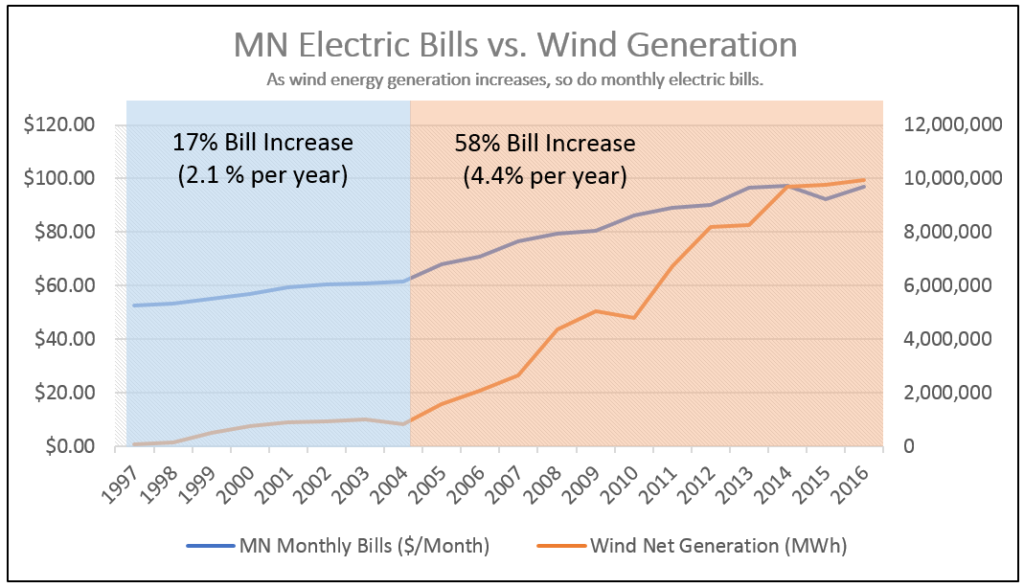
As you can see, as wind energy exceeded three percent of total generation in Minnesota in 2005, electric bills started increasing by 4.4 percent per year on average.
Contrarily, before Minnesota utilities spent billions of dollars on wind energy in the state, electric bills only increased by 2.4 percent per year on average.
Even after adjusting for inflation, electric bills from 1997 to 2004 increased by merely 0.5 percent, or not even one-tenth of a percentage per year. From 2004 to 2017, however, electric bills increased by 20 percent, or by 1.6 percent per year in real 2017 dollars.
Electricity rates show a similar pattern.
From 1990 to 2004, electricity rates actually dropped by nearly 20 percent, in inflation-adjusted dollars, shown in the chart below. By 2017, electricity rates rose again by 25 percent – completely erasing the progress made to keep electricity costs affordable in the years prior.
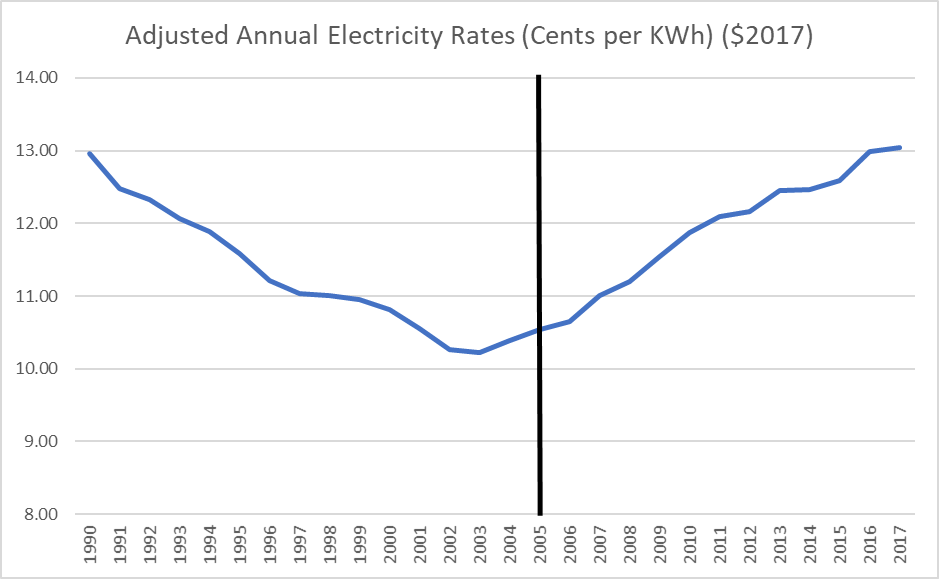
Why did the cost of electricity take such a turn after 2004? Because that’s when Minnesota utilities started investing heavily in wind energy, which increased the revenue they needed to recover through ratepayers in the state.
As you can see from the chart below, inflation-adjusted revenue from residential electricity sales rose gradually from 1997 to 2004, largely in relation to the amount of sales increasing – as electricity sales grew by 2.9 percent per year, on average, total revenue increased by 1.9 percent per year.
However, after 2004, total revenue started increasing by 2.5 percent per year, despite electricity sales only increasing by less than one half of a percent per year. Revenue was no longer increasing or decreasing due to selling more electricity.
What this means is that something other than increasing sales was causing total revenue to continue rising. As the chart below explains, total revenue from residential sales continued to increase because utilities continued to build new and expensive power plants.

You see, from 1990 to 2004, Minnesota largely relied on existing power plants to generate electricity, only building a new power plant when electricity demand required it. This kept electricity costs low because utilities weren’t constantly investing in new energy sources – which increases the number of assets they need to pay off and, thus, their “revenue requirement,” as well.
This all changed in the early 2000’s and especially after the Next Generation Energy Act (NGEA) passed in 2007, when Minnesota utility companies began building renewable energy facilities at increasingly alarming rates – not to reliably meet an increase in electricity demand (because demand didn’t increase), but to satisfy irresponsible public policies mandating them to build more renewable energy sources.
When it comes to electricity in Minnesota, affordability should be our main concern.
As long as we allow the wishful thinking of advocates desperately attempting to make wind energy a viable option to control the discussion, Minnesota ratepayers will continue to see the cost of electricity increase.